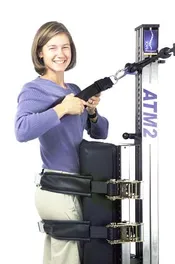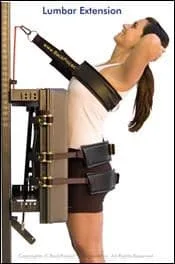
In more detail the BackProject's patented ATM2 device enables personalized body repositioning for finding a unique, pain free position for each user. Once this position is found, the device stabilizes the patient allowing specific neuromuscular training based on body movement that aims to achieve and sustain immediate pain reduction, to increase range of motion, and to improve function.
Here is an example. The goal of the ATM2 is to reposition and stabilize an area of the body that has pain on movement. This is referred to as a movement disorder. For example, if the lower back is painful when leaning backwards, and the stabilizing straps of the ATM are placed around the pelvis and reduce or eliminate the pain, then there is a motion disorder component to this pain. By repositioning each side of the pelvis, either anterior/posterior or lateral/medial so all pain is eliminated, and then the treatment position is achieved. Once this position is found, the patient performs previously painful movements against resistance.

The patient performs 6 to 12 repetitions of a pain free motion or exercise while supported by the patented ATM2 device. Immediately after the treatment you should expect the previously painful movement to have an immediate and significant reduction in pain and an increase in range of motion.
FAQ
How safe is the ATM2?
The ATM2 is intended to bring the user from a painful situation to a pain free situation. Throughout the session the restraining belts prevent the stabilized area from returning to its previously painful situation. As long as the treatment is performed by a competent back clinician, and the Warnings and Operated Manual guidelines are followed, the ATM 2 is an extremely safe treatment.
How does it work?
First, it stabilizes an unstable area in the body which allows a motion or movement to become pain free. Second, it allows the central nervous system to reprogram the muscle activation patterns and re-educate the body that it can do a certain activity without pain. Typically, this directly increases pain free ranges of motion.
How long do treatments last?
Typically, the benefit of each ATM treatment builds upon the previous treatment. Progress is easy to monitor as pain free range of motion is the best indicator of improvement. In our experience, rate of improvement occurs more quickly when coupled with applied kinesiology or DTS traction, depending on the particular issue.
On what kind of patients would this treatment work?
The patient is evaluated to determine whether the ATM Concept is suitable. If pelvic or shoulder stabilization does not improve pain levels, then the ATM2 is probably not the therapy of choice. If previously painful movements become pain free using stabilization, then one can be quite sure that the user will benefit. Again, the pain free position is the key. If obtained, then pelvic, low back, neck and shoulder disorders typically respond quickly. These include a wide variety of diagnoses like joint disorders, disc disorders, muscle spasm and restriction, directional segmental hypomobility or hypermobility. The patient must be pain free during positioning and therapy to experience maximum benefit with this treatment.
